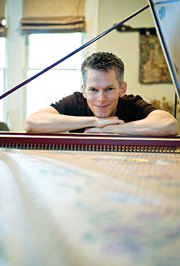Matthew Dirst leads the early music movement.
By Marene Gustin. Photo by Mark Hiebert

Matthew Dirst is only 46, but he and his partner Sixto Wagan (who is the co-executive director of DiverseWorks) reside in a renovated ’20s Craftsmen bungalow in the Heights, grow their own herbs in the garden out back, and listen to old music. Really, really old music.
That’s because the adorable Dirst is an associate professor of musicology at University of Houston’s Moores School of Music, where he directs the early music group Collegium Musicum; the organist for St. Philip Presbyterian Church; and is the founder and artistic director of Ars Lyrica, one of Houston’s budding Baroque ensembles.
“It’s just gorgeous music,” Dirst says. “And you don’t have to sit through a two-hour Mahler symphony to get it. It’s just pretty. What’s not to like?”
Houston does seem to like it. Houston Early Music presents some of the finest early music ensembles and soloists and the city boasts two performing groups, the popular Mercury Baroque and Ars Lyrica, which Dirst and friends founded as a nonprofit in 2004 and began performing in 2005. This season Ars Lyrica offers five concerts and two special events, kicking off with Legendary Lovers, September 19, at the Hobby Center for the Performing Arts’ Zilka Hall. The performance features excerpts from Orpheus & Euridice and Antony & Cleopatra, with soprano Ava Pine and mezzo-soprano Jamie Barton in cantatas and operatic excerpts by Handel, Clérambault, Gluck, and Hasse.
“I’ve worked with Jamie and Ava before,” Dirst says, “but not with Ars Lyrica. I’m excited to have them with us for the season opener and I chose this music for them. They are both just fantastic, young singers with fabulous careers ahead of them.”
Dirst, who hails from Illinois, was the first American musician to win major international prizes in both organ and harpsichord, including first prize at the American Guild of Organists National Young Artist Competition in 1990 and second prize at the inaugural Warsaw International Harpsichord Competition in 1993. He also plays a little clavichord, which, along with his harpsichord, are early music reproductions.
“The violins and cellos we use in Ars are originals, but the real harpsichords are all in museums now,” he explains. And while a lot of people think of early music as being from the Baroque period and before, Dirst says that nowadays it’s really more of a manner of performance, using instruments the composers of the times would have been familiar with. “It’s akin to the back-to-nature movement or organic farming,” he says.
Lest you think his life is all about music, Dirst and Wagan just returned from a trip to Turkey and Amsterdam, which you can read about on his blog on the Ars Lyrica website. The men also love to cook and entertain at home—when they can squeeze in the time. “Raiding the herb garden and whipping up a fresh pesto” is a summer delight for Dirst, but they also enjoy Asian food and Saturday mornings at the local farmers market. They’re even talking about getting a dog, but again Dirst adds, “when we have time.”
Down time may not be in much supply as Dirst heads back to classes at UH and Ars Lyrica launches into a new performing season. On top of all of that, Dirst is trying to finish a book on Bach. Bach as Idea is set to be published next year by Cambridge University Press.
With everything else on his plate, Dirst still sees more work ahead for Ars Lyrica. “We need to perform more, play more out of town,” he says. “And we need to record more. We have a disc coming out, but we need more.”
If all this sounds like a daunting task, one need only remember what Johann Sebastian Bach once said: “There’s nothing remarkable about it. All one has to do is hit the right keys at the right time and the instrument plays itself.”
For the rest of us less-than-musical geniuses, we can always just listen to Dirst play.
Marene Gustin also profiled Jonathon Glus for this issue of OutSmart magazine.
PHOTO CAPTION
Harmonious calling: Matthew Dirst lounges on the harpsichord at his Heights home that he shares with his partner, fellow Houston artsman, Sixto Wagan. The men are also members of the advisory board of the Texan-French Alliance for the Arts. This month the TFAA presents an exhibit of works created by hospitalized pediatric cancer and hematology patients of the Texas Children’s Cancer Center and Leon-Berard Hospital in Lyon, France. Details: www.arslyricahouston.org.










